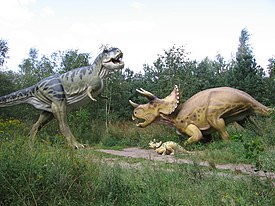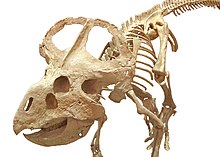Cultural depictions of dinosaurs
Any reconstruction is thereby an artist's view that, in order to stay within the limits of the best knowledge at the time, must necessarily be inspired by other pictures already scientifically proved.
The classical folklorist Adrienne Mayor has proposed that the profusion of literary descriptions and imagery of the griffin in Greek and Roman literature and art beginning in the 7th century BC to the 3rd century AD were influenced by observations and travelers' accounts of fossilized beaked dinosaur skeletons found in the Turpan and Junggar basins and Gobi Desert.
She noted that according to Aristeas, Sophocles, Herodotus, and other ancient writers, griffins were said to inhabit and lay eggs in nests on the ground in the lands beyond the Issedonian territory of the region surrounding the Altai Mountains.
[2] The palaeontologist Mark Witton notes in his blog that Mayor's suggestion ignores pre-Mycenaean accounts, and has not found favour with archaeologists including N. Wyatt and T.F.
[3][4][5] Many Near Eastern and Minoan artworks feature imaginary composite creatures, including quadrupeds with birds' heads but these were not called "griffins" and no writings link them to the strange beasts of Central Asia.
[9] In the same period, dinosaurs first appeared in popular literature, with a passing mention of an Owen-style Megalosaurus in Charles Dickens's Bleak House (1852–1853).
Despite the well-publicized "Bone Wars" of the late 19th century between the American palaeontologists Edward Drinker Cope and Othniel Charles Marsh, dinosaurs were not yet ingrained in culture.
Marsh, although a pioneer of skeletal reconstructions, did not support putting mounted skeletons on display, and derided the Crystal Palace sculptures.
[11] As study caught up to the wealth of new material from western North America, and venues for depictions proliferated, dinosaurs gained in popularity.
[13] Knight's work, found in museums around the United States, helped popularize dinosaurs and influenced generations of paleoartists.
[8][17] Dinosaur depictions diversified in the 1930s, spreading to newspaper comic strips in Alley Oop[17] and to advertising for Sinclair Oil.
[22] Films of the time typically used dinosaurs as monsters, with the added element of atomic fears in the early Cold War.
The book and a movie adaptation televised in 1968 by the NBC Children's Theatre tell the story of a boy who finds an enormous egg laid by a hen that hatches a baby Triceratops.
Jonas consulted with paleontologists Barnum Brown, Edwin H. Colbert and John Ostrom in order to create nine sculptures that were as accurate as possible.
Artists such as Mark Hallett, Doug Henderson, John Gurche, Gregory S. Paul, William Stout, and Bob Walters illustrated the new findings in response to the demand.
[37] For preschoolers, there was the educational television show Barney & Friends starting in 1992; their older siblings had the 1988 animated movie The Land Before Time and its increasing line of direct to video sequels (13 by 2016).
The popular ideals of dinosaurs have many misconceptions, reinforced by films, books, comics, television shows, and even theme parks.
[17][38] Moreover, dinosaurs did not become extinct due to being generally maladapted or unable to cope with normal climatic change, a view found in many older textbooks.
[42] However, some popular depictors have striven for accuracy and presented up-to-date information; Michael Crichton[38] and Bill Watterson (of Calvin and Hobbes)[43] are two recent examples.
Popular conceptions of dinosaurs have also been important in stimulating the interest and imagination of young people, and have been responsible for introducing many who would later become paleontologists to the field.
More than 20 years later, continually sustained paleontological interest from the public has even given rise to both a highly successful dinosaur theme park in the region and an aspiring UNESCO Geopark.
[44] In April 2016, a proposal was submitted to the Unicode Consortium to encode the heads of three dinosaurs considered exemplary, the Tyrannosaurus rex, the Brontosaurus, and the Triceratops, as emoji.











